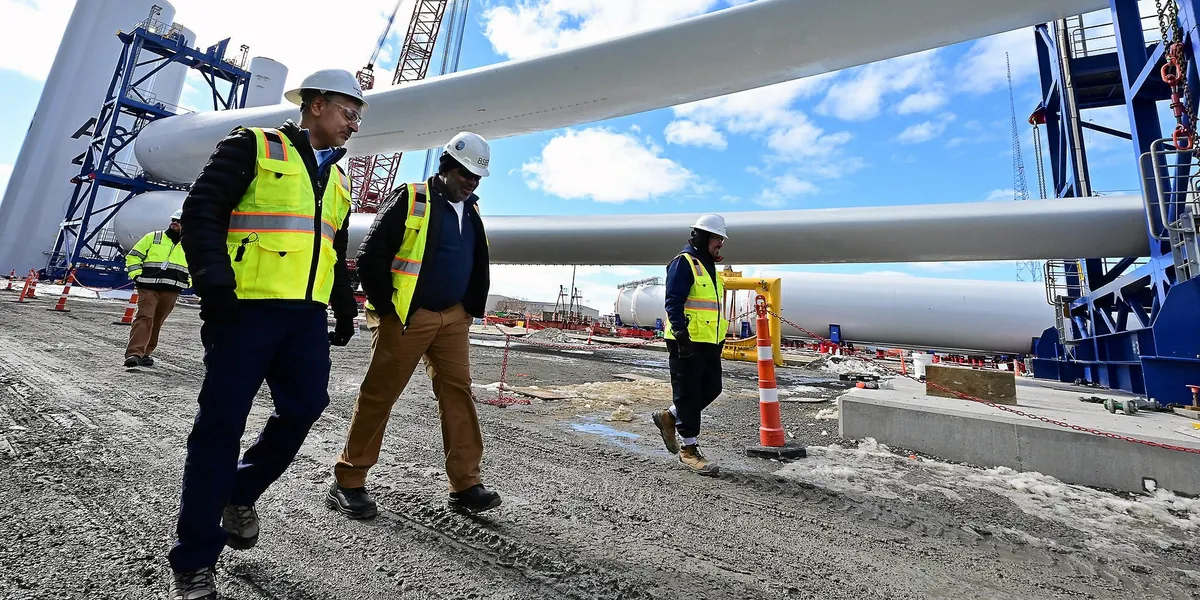
By Arcelia Martin | Inside Climate News
This article originally appeared on Inside Climate News, a nonprofit, non-partisan news organization that covers climate, energy and the environment. Sign up for their newsletter here.
John Belizaire says he has a secret hiding in plain sight. But before revealing it, the CEO of Soluna, a green data center development firm headquartered in Albany, New York, asks people to picture the last time they drove through a gusty stretch of countryside and saw wind turbines in the distance. But when they zoom into that frame, he asks, did they notice that not all of those turbines were spinning despite it being windy?
It’s not typically because they’re broken, Belizaire said. It’s because they’ve been turned off.
Electric grids across the country don’t always have the capacity to carry all of the energy an intermittent power plant can produce. So while at times there’s more than enough wind to produce more power, Belizaire said, there’s no place for that power to go due to aging transmission systems and a lack of local load.
That’s how we end up with stranded renewable energy—available energy going to waste because there isn’t a user for it. In an analysis of hundreds of renewable projects around the country, Soluna estimates upwards of 30 to 40 percent of renewable energy goes unused.
That’s the secret. There’s power already generated and ready to use, it’s just being curtailed, Belizaire said.
As power demand surges, largely due to data centers servicing artificial intelligence products and cryptocurrency, interested developers, power plant operators and environmentalists are trying to sort out how to use the full capabilities of existing renewable power plants. These decisions are playing out as more data center developers supply their own gas plants to secure onsite power and bypass lengthy wait times to connect to the grid.
More than a third of data centers are expected to adopt onsite power generation by 2030, according to a new survey of data center operators, utility companies and service providers from Bloom Energy, a fuel cell technology company. By 2035, that figure climbs to nearly half.
Data center developers want to have control over their timelines and have immediate access to power, said Aman Joshi, Bloom Energy’s chief commercial officer. The firm’s survey found there’s a one-to-two-year gap between when developers expect grid power and when utilities can realistically deliver it.
“Decisions around where data centers get built have shifted dramatically over the last six months, with access to power now playing the most significant role in location scouting,” Joshi said. “The grid can’t keep pace with AI demands, so the industry is taking control with onsite power generation.”
Soluna, like other data center developers looking to rely on renewable energy, buys the excess power from wind, hydro and solar plants that they can’t sell to the grid. By the end of the year, Soluna will have three facilities totaling 123 megawatts of capacity in Kentucky and Texas and seven projects in the works with upwards of 800 total megawatts.
Belizaire and I talked about how in Texas, where I report from, there’s plenty of curtailed energy from wind and solar farms because of the region’s transmission capacity. In West Texas, other data center developers are also taking advantage of the unused wind energy, far from major load centers like Dallas and Houston, by co-locating their giant warehouses full of advanced computers and high-powered cooling systems with the excess energy.
One data center developer using curtailed renewable power in Texas is IREN. The firm owns and operates facilities optimized for Bitcoin mining and AI. It developed a 7.5 gigawatt facility in Childress and broke ground on a 1.4 gigawatt data center in Sweetwater.


IREN purchases power through the state grid’s wholesale market during periods of oversupply, said Kent Draper, the company’s chief commercial officer, and reduces its consumption when prices are high. It’s able to do that by turning off its computers and minimizing power demand from its data centers.
But curtailment is an issue all over the world, Belizaire said, from Oklahoma, North Dakota, South Dakota, California and Arizona in the U.S., to Northern Ireland, Germany, Portugal and Australia.
“Anywhere where you have large utility scale renewable development that’s been built out, you’re going to find it,” Belizaire said.
In a March analysis, the U.S. Energy Information Administration reported that solar and wind power curtailments are increasing in California. In 2024, the grid operator for most of California curtailed 3.4 million megawatt hours of utility-scale wind and solar output, a 29 percent increase from the amount of electricity curtailed in 2023.
A Soluna report, using data from regional transmission organizations and independent system operators, estimated that at the end of 2021 there were 14.9 terawatt hours of wind and solar generation curtailed, or the equivalent of $610 million in lost revenue. The renewable electricity wasted in 2021 was enough to power 1.3 million households for a year, the report found.
So how does Soluna go about using curtailed energy?
The firm co-locates its data centers at a renewable energy plant and signs a power purchase agreement with the plant for a portion of its capacity. That way, the power producer can still satisfy its other obligations, like to the grid. The contracts used to be for around five years, but now they average about 10.
Soluna’s behind-the-meter strategy allows the company to source power in three ways. Its officials can buy it directly from the source at a low fixed price. It’s a cheap rate as that power would have been otherwise wasted. Or Soluna can use subtractive energy, paying for electrons directly from the wind farm that would have been sold to the grid. As a last resort, they can buy power directly from the grid. (It’s a less ideal option because depending on the makeup of the grid, it’s a mix of renewable and fossil fuel sources.)
This distributed generation approach has allowed Soluna to score some of the lowest prices for power this kind of data center has seen, Belizaire said, and source upwards of 75 percent of its energy from green sources.
Because of the intermittent nature of renewables, grids are grappling with how to maintain stability and reliability as they become more reliant on variable energy sources. Battery storage technology has made meaningful contributions but is still working to scale and upgrading transmission lines infamously takes a long time.
Soluna sees its flexible load data centers as a solution. The data centers can ramp down their computing when the grid needs more energy and ramp up when there’s excess energy to take.
“We’ve become almost like a battery,” Belizaire said. “I like to say computing is a better battery than battery systems.”
Inside Clean Energy is ICN’s weekly bulletin of news and analysis about the energy transition. Send news tips and questions to [email protected].







